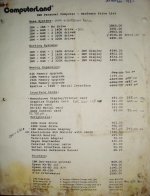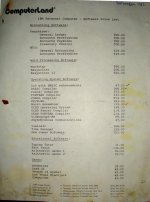Andrettigto
Experienced Member
I'm interested in learning how the serial numbering worked during the PC's production life.
Did they start with zero or like cars, use only part of the number for sequence? When the XT came out, did IBM just keep increasing the number or start at zero again? At EBay auctions, when a seller lists a number, how do you gauge "where" it is in terms of the calender years?
I've searched the forums here but could not find anything on this topic. There's probably something on the web but I can't seem to find anything either.
Maybe some fellow owners who are interested could give some input on what sort of data would be worth collecting.
Possible things to list:
- model PC or XT
- motherboard type (64k or 256k)
- serial number
- purchase date (if even known)
- capacitors on ends of memory banks? (I read that some didn't have them?)
- Cassette port? Was it always on the PC only? Relay, same thing?
- power supply color (or were they all black?)
- Drive cage design? When did they modify it to hold half heights?
- Dip switches always blue?
O.K. so here's my system:
PC 64k
0238960, around Oct.'81
caps beside dimms and at board edge
cassette and relay
black p/s (upgraded now)
Full height mount only (fabricated brackets to hold half height 225's)
Baby blue switch box
So please share what you have and tell me where I'm wrong here.
Carlos
Did they start with zero or like cars, use only part of the number for sequence? When the XT came out, did IBM just keep increasing the number or start at zero again? At EBay auctions, when a seller lists a number, how do you gauge "where" it is in terms of the calender years?
I've searched the forums here but could not find anything on this topic. There's probably something on the web but I can't seem to find anything either.
Maybe some fellow owners who are interested could give some input on what sort of data would be worth collecting.
Possible things to list:
- model PC or XT
- motherboard type (64k or 256k)
- serial number
- purchase date (if even known)
- capacitors on ends of memory banks? (I read that some didn't have them?)
- Cassette port? Was it always on the PC only? Relay, same thing?
- power supply color (or were they all black?)
- Drive cage design? When did they modify it to hold half heights?
- Dip switches always blue?
O.K. so here's my system:
PC 64k
0238960, around Oct.'81
caps beside dimms and at board edge
cassette and relay
black p/s (upgraded now)
Full height mount only (fabricated brackets to hold half height 225's)
Baby blue switch box
So please share what you have and tell me where I'm wrong here.
Carlos


